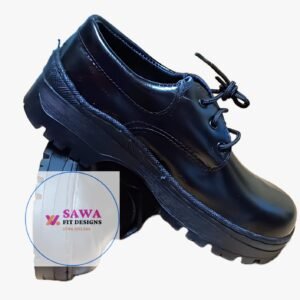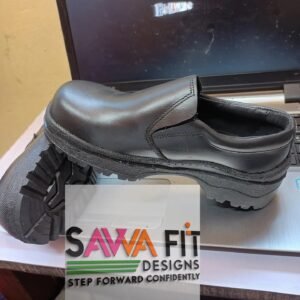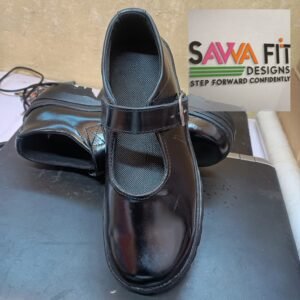Kenyan footwear market
Explore Kenya’s growing footwear market—key drivers, consumer trends, competitive players, and investment opportunities. Learn about market size, e-commerce growth, and sustainability innovations.
-
Back to School Shoes -Genuine Pure Leather
Original price was: KSh1,300.KSh1,000Current price is: KSh1,000.Select options This product has multiple variants. The options may be chosen on the product pageClear3234242526272829303133 -
Boys Black School Shoes
Original price was: KSh1,500.KSh1,200Current price is: KSh1,200.Select options This product has multiple variants. The options may be chosen on the product pageClear363835373940 -
Slip-On School Shoes Boys
Original price was: KSh2,500.KSh2,000Current price is: KSh2,000.Select options This product has multiple variants. The options may be chosen on the product pageClear323436382728293031333537 -
Girls School Shoes (Buckle)
Original price was: KSh1,800.KSh1,400Current price is: KSh1,400.Select options This product has multiple variants. The options may be chosen on the product pageClear3837
Stepping into Opportunity: Kenya’s Evolving Footwear Market
Market Overview: Steady Growth Ahead
Kenya’s footwear market is on a solid growth path. With rising urbanization and increasing disposable incomes, consumer spending on footwear is projected to reach KES 285.5 billion (USD 2.2 billion) in 2025—a 7.9% year-on-year increase . By 2029, this could hit KES 400 billion (USD 2.8 billion), driven by a young, urbanizing population and expanding middle class .
Key drivers include:
- Purchasing power growth: Household purchasing power in 2025 is 15% higher than pre-pandemic levels .
- Fashion influence: Global brands like Adidas entering Kenya (e.g., Nairobi’s Westgate Mall store) signal rising consumer aspirations .
- E-commerce acceleration: Online footwear sales could reach USD 60.9 million by 2029, up from USD 42.5 million in 2025 .
Market Segments: Where Demand Is Concentrated
Athletic Dominates:
Athletic footwear leads sales, fueled by health awareness and sports participation. Brands like Nike and Adidas are capitalizing on this trend .
Material Preferences:
- Rubber/plastic footwear: Holds the largest share (affordable, durable, climate-suited) .
- Leather: Growing in formal/sustainable segments but faces cost challenges .
Table: Kenya Footwear Market Segmentation
| Category | Dominant Segment | Key Driver |
|---|---|---|
| Type | Athletic | Fitness trends, youth adoption |
| Material | Rubber/Plastic | Affordability, durability |
| Price Tier | Mid-market | Expanding middle class |
E-commerce: The Digital Shift
Online channels are reshaping access:
- Monthly revenue hit USD 3.4 million in May 2025 .
- Top platforms: Jumia leads with USD 900K in 2024 sales .
- Seasonal spikes: November sales surge 10.3% due to holiday buying .
Mitumba Challenge: Second-Hand Dominance
Kenya’s massive second-hand trade (mitumba) employs 2 million people and meets 70% of clothing/footwear demand . This pressures local manufacturers but drives circular economy innovation. Policy proposals (e.g., requiring mitumba sellers to stock 10% local goods) aim to balance growth .
Sustainability & Local Innovation
Eco-conscious brands are emerging:
- Pine Kazi: Creates shoes from pineapple leaves and recycled tires. Won Fashionomics Africa’s 2025 sustainable design contest .
- Government support: “Buy Kenya, Build Kenya” campaigns boost local sourcing .
Export Potential: Regional Reach
Kenya exported USD 20.95 million in footwear in 2023, with Uganda as the top destination (USD 9.93 million) . Rubber/plastic exports dominate (USD 8.41 million to Uganda), highlighting manufacturing strengths .
Competitive Landscape
- Global brands: Adidas, Nike (athletic focus) .
- Local players: Sawafit Kenya (retail network), Umoja Rubber (durable rubber footwear) .
- Innovators: Pine Kazi (eco-designs) .
Table: Kenya’s Key Footwear Export Products (2023)
| Product Category | Export Value to Uganda |
|---|---|
| Rubber/plastic footwear | USD 8.41 million |
| Waterproof rubber/plastic footwear | USD 1.29 million |
| Leather upper footwear | USD 143.31K |
The Road Ahead: Challenges & Opportunities
Hurdles:
- Cheap imports (75.8% from China) pressure local factories .
- Raw material costs and mitumba competition .
Opportunities:
- Athletic & sustainable segments: High growth potential .
- E-commerce expansion: Reaching rural consumers .
- AFCFTA access: Leveraging continental trade agreements .
Final Insights
Kenya’s footwear market blends tradition and innovation. While mitumba remains a staple, brands like Pine Kazi and global entrants show where the market is heading: digital, sustainable, and responsive to Kenya’s young, aspirational consumers. Investors should watch athletic footwear, e-commerce channels, and export-ready local manufacturers.
-
Back to School Shoes -Genuine Pure Leather
Original price was: KSh1,300.KSh1,000Current price is: KSh1,000.Select options This product has multiple variants. The options may be chosen on the product pageClear3234242526272829303133 -
Boys Black School Shoes
Original price was: KSh1,500.KSh1,200Current price is: KSh1,200.Select options This product has multiple variants. The options may be chosen on the product pageClear363835373940 -
Slip-On School Shoes Boys
Original price was: KSh2,500.KSh2,000Current price is: KSh2,000.Select options This product has multiple variants. The options may be chosen on the product pageClear323436382728293031333537 -
Girls School Shoes (Buckle)
Original price was: KSh1,800.KSh1,400Current price is: KSh1,400.Select options This product has multiple variants. The options may be chosen on the product pageClear3837
Sources: Fitch Solutions , 6Wresearch , Fashionomics Africa , Trade Economics .
Kenyan footwear market



